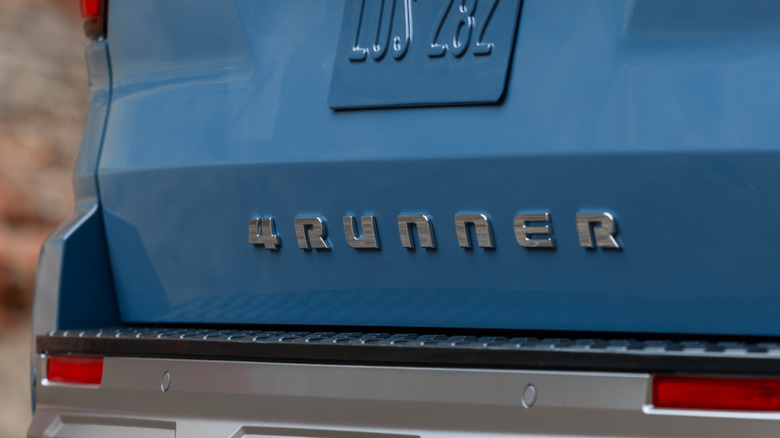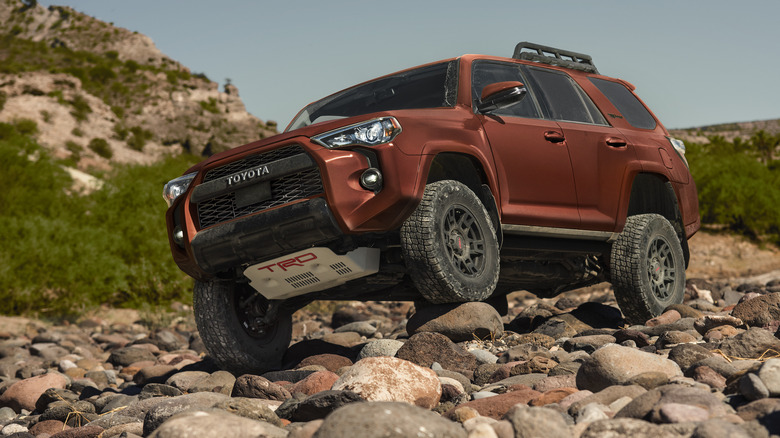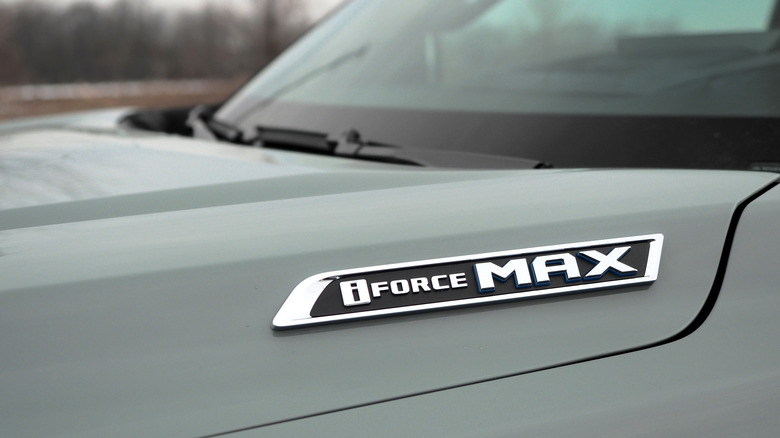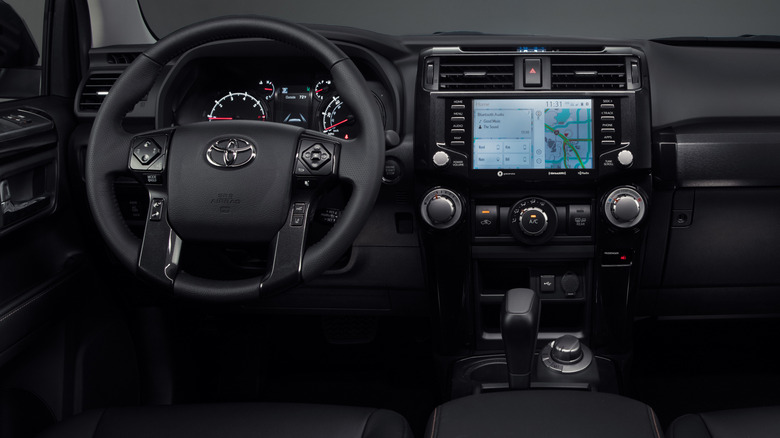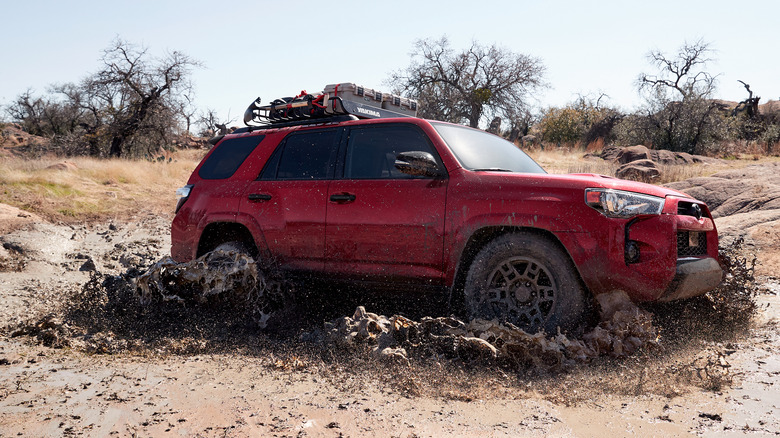4 Ways We Expect The 2025 Toyota 4Runner To Change - And Why It Needed A Redesign
Toyota is sitting on nameplate gold, but cashing that in is riding on the 2025 4Runner living up to a confusingly high bar. Expected to make its full appearance imminently, the all-new sixth-generation 4Runner certainly hasn't been fast to arrive. In fact, with the current SUV dating back to 2009, you could well accuse Toyota of being a little tardy with its attentions.
Certainly, a 4Runner update is something fans of the SUV have been calling out for. Yet, you could also make the case that Toyota's patience for this 2025 upgrade is a timely one. For one, it taps its current conflation of vehicle platform, in-cabin technology, and engine developments.
We've seen how those individual advances impact some of Toyota's most popular SUVs, trucks, and crossovers. Now, it's the 2025 4Runner's turn to bring them all together. The big question, then, is not only what Toyota is likely to do with its best-selling SUV, but why that'll be such a big deal to 4Runner fans.
The 2025 4Runner will probably use the new Tacoma's platform
With the current 4Runner now a decade and a half old, it's perhaps no surprise that the platform it runs on feels outdated. Toyota isn't expected to stray from the all-important body-on-frame design that SUV enthusiasts feel so strongly about, of course, but it's a fact of auto industry life that it can't simply build a truck for roaming the wilderness alone. The market has moved on, and for the 2025 4Runner, the expectation is that Toyota will look to the newest Tacoma for a platform buddy.
The Tacoma underpinnings are important because Toyota's midsize pickup has seen a significant glow-up itself, recently. The fourth-generation truck tapped the TNGA-F body-on-frame platform, in the process promising not only the same off-road talents that long-time enthusiasts have loved, but a genuine uptick in on-road refinement with it.
That's a tough balance to strike, but Toyota seems to have achieved it. Our own experience with the 2024 Tacoma off-road made clear that the newest iteration of the pickup was still content out in the rough stuff. However, when we reviewed the new Tacoma on the road, the difference between the faintly agricultural old pickup and this new model was vast. If the 2025 4Runner can channel that same rugged/refinement combination, that would be a big step forward compared to the existing SUV.
Perfect timing for punchy hybrid engines
Back in 2009, a naturally-aspirated 4.0-liter V6 gas engine didn't seem such a bad idea, replacing the larger, thirstier V8 of the fourth-generation 4Runner. Fast-forward to today, though, and the 270 horsepower and 278 lb-ft of torque seem miserly, while the five-speed automatic transmission is positively archaic. As we discovered in our review of the 2023 4Runner 40th Anniversary Edition, not only is the current V6 lackluster, but it's rough on fuel economy too.
Handily, Toyota isn't short on solid engine options these days, including some with electrification that simply wasn't available when the existing 4Runner was developed. Again, the new Tacoma gives us a good idea of what's possible: its 2.4-liter turbocharged inline-four in the base-spec truck may be smaller in capacity and down on cylinders compared to the old V6, but with 278 horsepower and 317 lb-ft of torque it's markedly more potent. Toyota also pairs it with a far more modern 8-speed automatic transmission.
It's the hybrid options which may be more exciting, though. Branded i-FORCE MAX, they combine a gas engine with an electric motor. The exact pairing varies — Toyota has turbocharged inline-four and twin-turbocharged V6 versions — but the upshot is always more low-end torque from the electric contribution, and a truck that feels perkier at urban speeds. While they may buck the usual assumption that electrified means more frugal, even the 437 horsepower hybrid V6 in the latest Tundra gets better mpg numbers than the current 4Runner's V6.
Upgrading Toyota's worst offender for dashboard tech
Looking at the dashboard of the 2024 4Runner is like peering through a time machine. The auto industry may be circling back to the idea that physical knobs and buttons aren't necessarily a bad thing when you're trying to keep drivers' attention on the road, but the current SUV's dated infotainment system and clunky switchgear are arguably where the 4Runner is most showing its age.
Luckily, Toyota won't need to look far to find an example of how to do dashboard design and technology much, much better. In fact, it needs only wander across the dealership floor to the latest Tacoma, Sequoia, or Grand Highlander for some ideas: each has benefitted from Toyota's latest infotainment system, bigger and crisper touchscreens, and a significant improvement in the look and feel of the physical controls.
Given what we've seen in the new 2024 Land Cruiser and Tacoma, a physical shifter seems likely to appear in the new 4Runner too. However, much more ergonomic buttons and knobs for navigating through off-road settings like differential locks and drive modes are equally inevitable, and it's tough to imagine Toyota ditching a physical climate control panel, too. That'll almost certainly be combined with features like the much-improved voice control system, wireless Apple CarPlay and Android Auto, and other niceties leagues ahead of what current 4Runner owners could even dream of.
Reliability is the 4Runner wildcard
A more potent, more frugal engine, along with a cabin upgrade and a boatload of new technology, almost sells itself. Toyota's biggest pitch for the 2025 4Runner, though, may well end up being around something more esoteric — albeit no less important to owners for that.
Reliability has become the 4Runner's secret weapon over the years. Yes, rivals are more refined, and have more power; yes, its tech package is woeful and its aging drivetrain unrefined. Yet, a reputation for near-bulletproof reliability has made the 4Runner the go-to for many drivers when it comes to an SUV that can be relied upon — and readily repaired — away from the asphalt.
Toyota can't afford to let that reputation slip, though it's a fact of life that the more gadgetry you put into a new car, the more points of failure you're introducing too. A sturdy warranty will certainly help: the latest 2024 Sequoia, for instance, is covered for 36 months or 36,000 miles, and more for the powertrain, corrosion, and the hybrid system particularly. When 4Runner fans are used to thinking of ownership in terms of decades, not the duration of an average lease, though, more may be required.
Just as with the reaction to the 2024 Land Cruiser, there'll undoubtedly be a groundswell of interest in a revamped nameplate. For all the gadgets and refinement potential, though, only time will tell whether the sixth-generation 4Runner earns its spot in the SUV history books.
